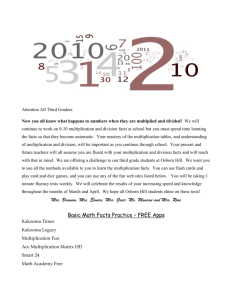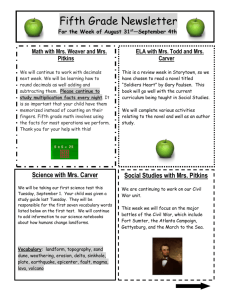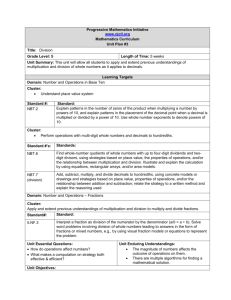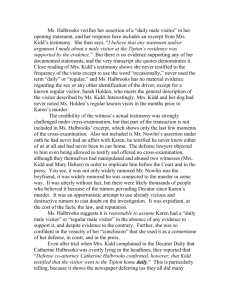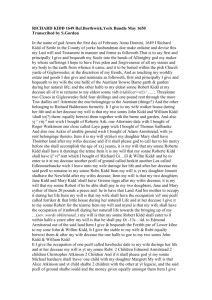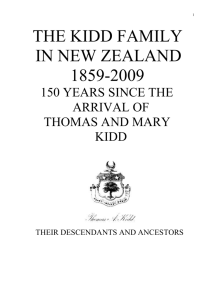5 th Grade News and Information
advertisement
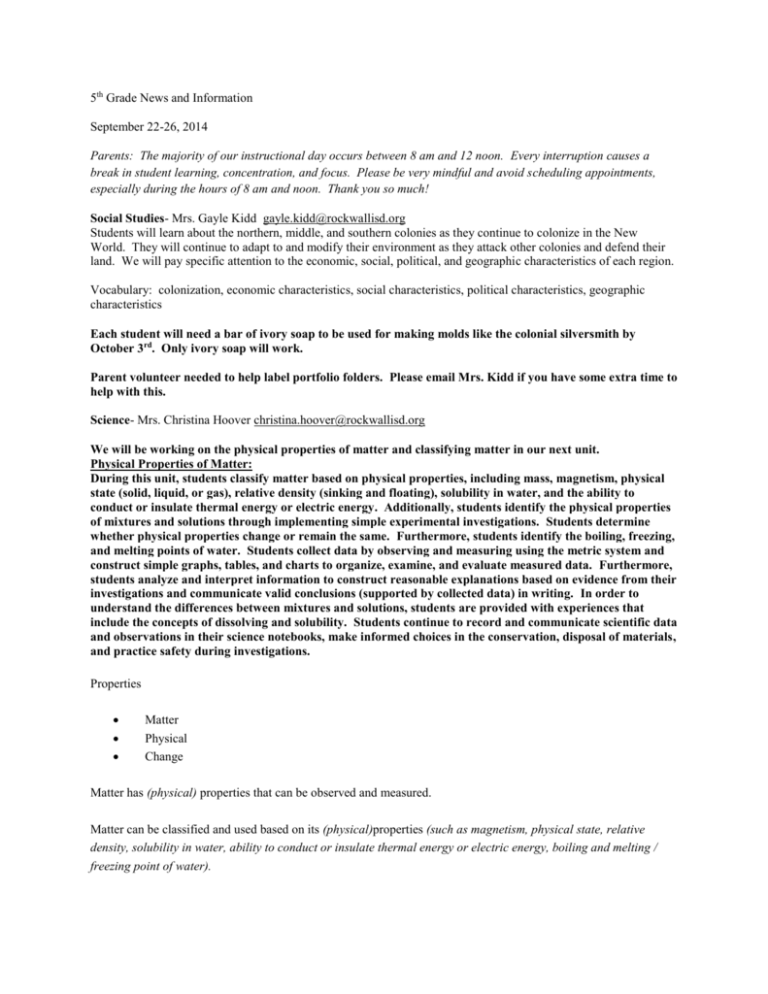
5th Grade News and Information September 22-26, 2014 Parents: The majority of our instructional day occurs between 8 am and 12 noon. Every interruption causes a break in student learning, concentration, and focus. Please be very mindful and avoid scheduling appointments, especially during the hours of 8 am and noon. Thank you so much! Social Studies- Mrs. Gayle Kidd gayle.kidd@rockwallisd.org Students will learn about the northern, middle, and southern colonies as they continue to colonize in the New World. They will continue to adapt to and modify their environment as they attack other colonies and defend their land. We will pay specific attention to the economic, social, political, and geographic characteristics of each region. Vocabulary: colonization, economic characteristics, social characteristics, political characteristics, geographic characteristics Each student will need a bar of ivory soap to be used for making molds like the colonial silversmith by October 3rd. Only ivory soap will work. Parent volunteer needed to help label portfolio folders. Please email Mrs. Kidd if you have some extra time to help with this. Science- Mrs. Christina Hoover christina.hoover@rockwallisd.org We will be working on the physical properties of matter and classifying matter in our next unit. Physical Properties of Matter: During this unit, students classify matter based on physical properties, including mass, magnetism, physical state (solid, liquid, or gas), relative density (sinking and floating), solubility in water, and the ability to conduct or insulate thermal energy or electric energy. Additionally, students identify the physical properties of mixtures and solutions through implementing simple experimental investigations. Students determine whether physical properties change or remain the same. Furthermore, students identify the boiling, freezing, and melting points of water. Students collect data by observing and measuring using the metric system and construct simple graphs, tables, and charts to organize, examine, and evaluate measured data. Furthermore, students analyze and interpret information to construct reasonable explanations based on evidence from their investigations and communicate valid conclusions (supported by collected data) in writing. In order to understand the differences between mixtures and solutions, students are provided with experiences that include the concepts of dissolving and solubility. Students continue to record and communicate scientific data and observations in their science notebooks, make informed choices in the conservation, disposal of materials, and practice safety during investigations. Properties Matter Physical Change Matter has (physical) properties that can be observed and measured. Matter can be classified and used based on its (physical)properties (such as magnetism, physical state, relative density, solubility in water, ability to conduct or insulate thermal energy or electric energy, boiling and melting / freezing point of water). Some physical properties of matter may change (such as heating and cooling cause change in water). Misconceptions: Students may think the physical property of an object changes with increased or decreased amounts of matter. Students may think mass and volume, which both describe an "amount of matter", are the same property. Students may think gases are not matter because most are invisible. Students may think density is the thickness of something, rather than understanding density is a measurement of mass per unit volume. Students may think large objects always sink and small objects always float. Key Content Vocabulary: Boiling point – the temperature at which a substance changes from a liquid to a gas; for water this temperature is 100°C Celsius – the international scale of measurement for temperature Conductor – a substance or object that allows energy to flow through it easily Dissolving – the process by which substances breakdown into small pieces and spread evenly in liquid (water) Electrical energy – energy that is absorbed or delivered by an electric circuit Insulator – a substance or object that does not allow energy to flow through it easily Magnetism – a force of attraction that causes a magnetic material to move Mass – the amount of matter in something Matter – anything that has mass and takes up space Melting / freezing point – the temperature at which a substance changes from a liquid to a solid or a solid to a liquid by the loss or addition of heat; for water this temperature is 0°C Mixture – a combination of two or more substances that can be easily separated in some physical way Physical properties – properties of matter that can be observed, measured, or changed without changing the matter itself Properties – characteristics used to identify matter Relative density – floating or sinking when compared to water Solubility – the ability of a substance to dissolve in another substance, such as sugar dissolving in water Solution – a type of mixture in which the particles of one or more substances are uniformly dispersed (spread out) throughout another substance Temperature – a way of measuring how hot or cold something is; temperature is measured using either the Fahrenheit (F) or Celsius (C) scale Thermal / heat energy – energy related to the temperature of an object or a substance Volume – the amount of space that a substance or object takes up Math- Mrs. Kathy Riley kathy.riley@rockwallisd.org and Mrs. Becki Hensel rebecca.hensel@rockwallisd.org During this unit, students represent multiplicative structures (multiplication) of problem situations with products and decimals to the hundredths with the use of concrete objects, pictorial models, and area models. These models serve as a bridge between whole-number multiplication and should help students to assimilate new understandings involving decimal multiplication. There is an emphasis on representing multiplication before solving for products of decimals to allow for the development of the conceptual understanding before procedural understanding. Students are expected to estimate to determine and solve for products, and simplify numerical expressions that include multiplication of whole numbers and decimals. The number set within this unit is limited to products to the hundredths. Factors may include decimals through the thousandths place as long as the product is only through the hundredths place. Reading- Mrs. Tammy Lang tamra.lang@rockwallisd.org Students will be using graphic organizers to map out stories. We will analyze the literary elements of a story, such as characters, setting, problem and solution. By analyzing these elements, students will improve their reading comprehension skills. Student will read the historical fiction novel, The Lion to Guard Us, (Clyde Bulla) and focus on analyzing the characters of the 17th century as they travel to the New World as colonists. Students will write poetry based on a chosen character from the story, including figurative language that they have become quite familiar with since the beginning of the school year. Help students get in the routine of reading nightly for thirty minutes, and sharing their agenda nightly for you to sign, acknowledging that this reading has occurred and that the agenda has been shown to you. Thank you for your support that allows us to help each student become a better reader this year! Important Dates: September 26 Camp $ Due ($160 per camper, $100 per chaperone) October 1 CLP Spirit Night at Chick Fil-A October 13-15 Camp Grady Spruce

